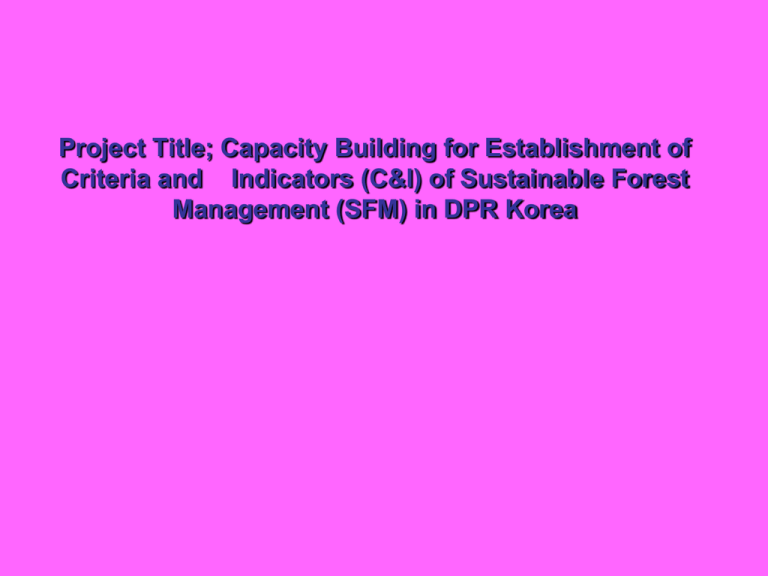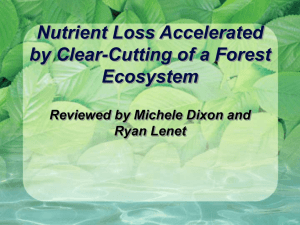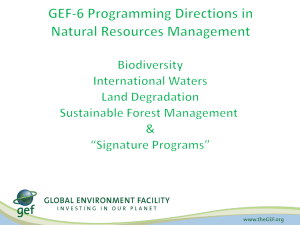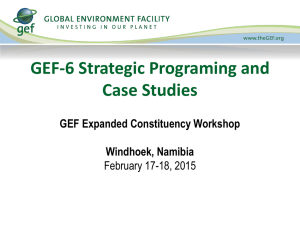Sustainable Forest Management 2012 Proposal - US
advertisement

Project Title; Capacity Building for Establishment of Criteria and Indicators (C&I) of Sustainable Forest Management (SFM) in DPR Korea Background Forest areas have rapidly decreased during 1990~2005 due to the shortages of food and energy, and not less forest had been deforested and degraded. The form of deforestation /forest degradation decrease in forest land area is tree stocking, land plant cover, soil organic matter and field moisture-holding capacity, serious soil erosion and landslide, soil drying and compaction, destruction of food chain The form of deforestation /forest degradation Decrease of adaptation capability to the abnormal climate phenomenon due to climate change The influence of deforestation /forest degradation Continuation of the loss, segmentation, isolation and qualitative deterioration of habitats due to degradation /destruction of forest ecosystems The main factor of deforestation /forest degradation the shortage in the capacity for sustainable management of forest resources and in the financial resource Justification The Branch of Forest Science (BOF), State Academy of Science as one and only national organization responsible for forest science • The task of Branch of Forest Science assurance of successful scientific forest policy-making and its performance nationwide and provision of scientific and technological information on tree breeding, tissue culture, establishment and management of economic forests, mechanization of forestry, afforestation and reforestation, forest protection, forest ecosystem management and organizing of forest management. • The composition of Branch of Forest Science 7 central institutions, one doctoral course and 4 local institutions The Institute of Forest Management (IFM) as an affiliated organ of BOF • The composition of IFM 7 departments (nursery, seedling growing, forest ecosystem management, afforestation/reforestation, watershed management, reorganizing forest management and digital forest comprehensive analysis,), 6 pilot forests and 150 members • The experiences in international corporation - The run of technical cooperation program FAO/TCP/DPR/0169(A) as a qualified national expert for modeling and demonstration of participatory integrated watershed management under the aid of IUFRO and FAO - The assessment of mitigation function of forest in drawing of the second national report on climate change under the aid of UNEP and the registration of Mt. Paekdu Biosphere Reserve to International Biosphere Reserve • The topics of IFM - Development of the strategy for restoration and management of disturbed/degraded forests - Building-up a forest management information system, - Solution of scientific and technological problems rising in the establishment of scientific and advanced framework of national SFM strategy • The problem of IFM - The research work on the development and adoption of forest certification scheme, assessment of forest value and establishment of early-warning system in watershed level and mitigation methodology is only on the search step. - The financial and equipment shortage has been a big problem in the foundation of new research department that will take charge of the SFM study and in the doing of detailed research depending on the advanced approach. Goal and objective establishing SFM information center and making it as a dissemination base to collect and analyze the advanced world scientific achievements on SFM as soon as possible and present scientific and technical methods for dissemination nationwide. Outcome and Action • • • • • • • • Outcome 1 Establishing of SFM information center with powerful brain/hardware capacity in IFM, Forest Science Branch, SAOS, DPR Korea. Activity 1.1 30 scientists capable of SFM research to be elected. Activity 1.2 An office for the SFM research to be supplied with. Activity 1.3 1st international training to be taken place on the selection, survey and monitoring of SFM C&I s. Activity 1.4 Justification of 7 Montreal process Criteria to be consulted. Activity 1.5 Justification and applicability of 67 Montreal process Indicators to be consulted. Activity 1.6 100 ha of demonstration site to be selected in the Taedong county, South Pyongan province, western low-land region of DPR Korea, in which SFM C&I s are practically measurable. Activity 1.7 Equipments necessary for SFM C&I measurement to be procured Activity 1.8 1st national workshop to be taken place for the development of SFM C&I s. Outcome 2 SFM C&I s to be surveyed, and demonstration base to be established in the demo-site for the SFM in the lowland region, and the guideline to be made • Activity 2.1 Assessment of biomass in the project site tobe conducted. • Activity 2.2 Assessment of greenhouse gas sequestration and emission in the pilot site to be conducted in accordance with the IPCC guideline on the forest soil and biomass respectively, and errors by forest kind to be corrected through on –the-site survey, and guideline to be made. • Activity 2.3 Biodiversity assessment to be conducted and conservation and management measures to be taken in the site. • Activity 2.4 Forest value of the pilot site to be assessed and the guideline to be made. • Activity2.5 Advanced management system on the sustainable management approach to be established in the pilot and its proposal to be submitted. • Activity 2.6 The report to be made on the current state and priority of SFM in the pilot site. • • • • • Outcome 3 collection and analysis to be conducted of worldwide advanced science and technology information for solving fuels and food necessary for livelihood of rural people, while restoring and managing forest ecosystem, and the report to be made. Activity 3.1 2nd international training to be taken place on the advanced approaches to the restoration of forest ecosystem. Activity 3.2 reasonable ecosystem restoration models to be developed on the principle of silvo-agro, silvo-herb linkage to meet the need of forest ecosystem restoration and the inhabitants. Activity 3.3 tree species to be selected and planted according to the reasonable silvo-agro, silvo-herb model in the pilot site. Activity 3.4 the reasonable management method to be selected and the management to be implemented according to the model in the pilot site. Activity 3.5 2nd national workshop to be held and the report to be submitted on the restoration of forest ecosystem in the western lowland region. Outcome 4 capacity-building for the international approaches to the establishment of early-warning system for disaster prevention in the watershed, to the adoption of forest certification scheme, and to the assessment of forest ecosystem value to be enhanced. • Activity 4.1 3rd international training to be held on the advanced model for the forest ecosystem value assessment that has recently been used worldwide. • Activity 4.2 advanced SFM technologies to be propagated and awareness-raising activities to be enhanced through local research bodies and technology propagating bodies and publications. Sustainability of the action Beneficiaries/associat The role and Position es, stakeholders involvement of all stakeholders Role/Activities IFM Direct beneficiaries • Development of SFM C&I s and Establishing SFM assessment system • Establishing early-warning system against natural disasters and demonstrating mitigation methodologies • Developing and renewing of forest value assessment models • Dissemination and technical guidance of advanced eco-friendly techniques • Capacity building and writing for awareness raising Forest management organizations Indirect final beneficiaries Consulting and organizing to apply results in action site State Academy of Sciences associate Organizing to implement the action under the close connection with the government Risk analysis • The action could be successfully implemented under the following assumption. – The action will be approved. – The close contact between applicant, partners and subcontractors will be provided. – The research capacity for the new technology will be enhanced. – Financing activities of donors to be determined for the successful implementation of the project. – The equipments for the action performance will be offered and technical training and study tour etc. are carried out through the steering instrument. – The equipments and buildings will be provided to beneficiaries and assure the action sustainability. • There would be some risks for action implementation: - Physical risks; Weak technical capacity and physical capacity to O&M new equipment and to supply some spare parts for the action sustainability. - Environmental risks; - Political risks; - Economic risks; The finance, manpower, material and equipments may be restricted without preceded planning. Difficult to purchase all the equipments and materials at the action site. Difficult to keep the delivery date of equipment and materials from aboard. - Social risks; Difficult to ensure the action sustainability without providing purchased equipments and buildings to associates Weaken connection with education, publication, reporting and technique diffusion organizations as to be attention of performance in the action site Measures for risk mitigation and sustainability • To minimize the physical/economic risks; Performed activities for capacity building of researchers based on the pre-planning • To minimize the environmental risks • To minimize the political risks; • To minimize the social risks; - Arrangement of O&M team responsible and their capacity building should be included in the action. - Ensure to transfer ownership of purchased equipments and buildings to associates and final beneficiaries - Planning the data collection and edition for guideline on new applied techniques and site reporting, introducing widely the achievement/experience through all kinds of publications, academic symposium and visit, and express these on policy making as form of advise - Expect that unwilling contents including natural disaster, the assumptions, risks, and measures mentioned in the sustainability can be controlled by the action applicant, associate and stakeholders and have enough possibility for implementation. - The unexpected aspects in the concept not can be revised and supplemented while developing the detained action document. Estimated Budget № Cost 1 Human resource 2 Travel 3 Equipment and supplies 4 Local office 5 Other costs, services 6 other 7 Sub-total direct eligible cost of the Action(1-6) 8 Provision for contingency reserve(maximum 5% of 7, subtotal of direct eligible costs of the Action ) 9 Total direct eligible costs of the Action(7+8) 10 Administrative costs(maximum 7% of 9, total direct eligible costs of the Action) 11 Total eligible costs(9+10)









